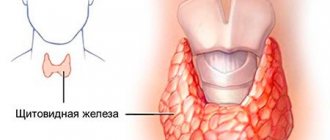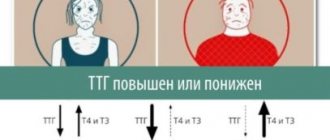| Author of the article: | |
| Sleptsov Ilya Valerievich, Doctor of Medical Sciences, endocrinologist surgeon, professor of the Department of Faculty Surgery of St. Petersburg State University, deputy director for medical affairs of the St. Petersburg Multidisciplinary Center of the Ministry of Health of the Russian Federation, member of the European Thyroidological Association, European Association of Endocrine Surgeons | |
| If you have been diagnosed with medullary thyroid cancer that requires surgical or chemotherapy treatment, or an increase in blood calcitonin levels, you can contact Ilya Valerievich Sleptsov by phone +7 921 9517088 to receive recommendations for diagnosis and treatment |
Detailed description of the study
Calcitonin is a hormone produced by the C cells of the thyroid gland. Its main function is to regulate mineral metabolism in the body.
Maintaining calcium levels within physiological limits is achieved through a balance between its absorption in the intestines, deposition in the bones and excretion from the body. The balance of these processes is provided by many hormones. The role of calcitonin is to prevent excessive increases in calcium concentration in the blood. This hormone acts on cells that destroy bone tissue (osteoclasts), slowing down the process of bone resorption.
Calcitonin receptors are found in many other organs, including the brain, kidneys and intestines. Secretion of the hormone occurs in response to an increase in calcium concentration in the blood. Its secretion is also stimulated by excess production of gastrointestinal hormones such as gastrin.
A change in calcitonin levels is observed in primary osteoporosis, which develops as an independent disease and is not associated with other pathology. Another reason for the increase in its concentration is medullary thyroid cancer. This is a fairly rare cancer that usually develops as part of a hereditary syndrome called multiple endocrine neoplasia. With this pathology, damage to the adrenal glands and other glands is observed.
Medullary thyroid cancer is often asymptomatic until the tumor spreads to other organs, that is, metastases appear. Its detection occurs accidentally during an ultrasound examination, where the node is visualized. As the disease progresses, a person may notice an enlargement of the lymph nodes in the neck, problems swallowing food, and hoarseness due to compression of the lumen of the esophagus, trachea, and nerves and vessels of the neck by the tumor.
Assessment of calcitonin levels is an important indicator in the diagnosis of medullary thyroid cancer, osteoporosis, in conjunction with other indicators of mineral metabolism in the body. Rarely, changes in calcitonin concentration may be observed in tumors of other locations.
Blood test for calcitonin
Blood calcitonin is now determined by various laboratories using equipment of various classes to study the level of this indicator. The most modern analyzers, which give the calcitonin analysis maximum accuracy, are 3rd generation immunochemiluminescent analyzers. Widespread and cheap to operate and handle, 2nd generation enzyme immunoassay analyzers provide a significant error in determining the level of calcitonin in the blood, which can lead to incorrect actions both at the stage of examining the patient and at the stage of his treatment. That is why, if during a blood test, calcitonin is the main indicator you are interested in, ask the laboratory what method is used to perform the analysis.
The laboratory of the North-Western Endocrinology Center performs a blood test for calcitonin using an automatic 3rd generation immunochemiluminescent analyzer Liaison XL manufactured by DiaSorin (Italy)
– one of the world's largest manufacturers of equipment for studying blood hormone levels. The accuracy of calcitonin testing using the high-tech 3rd generation method is so high that it often eliminates the errors of tests performed by other laboratories using less modern methods. Very often, patients who have elevated blood calcitonin turn to the North-Western Endocrinology Center - and often a simple double-check of the results using precision equipment makes it possible to find out that in fact the hormone is within normal limits.
| Automatic immunochemiluminescent analyzer 3rd generation DiaSorin Liaison XL (Italy) | 3rd generation chemiluminescent immunoassay analyzer for determining blood calcitonin levels with maximum accuracy |
Why is calcitonin so interesting to endocrinologists and endocrinologist surgeons? The fact is that from the C-cells that produce this hormone, a very dangerous malignant tumor of the thyroid gland grows, which is called medullary cancer or C-cell carcinoma. Medullary cancer grows slowly (this is perhaps its only positive quality), but extremely stubbornly - it is not “afraid” of chemotherapy, with the exception of some drugs from the group of kinase inhibitors, and also does not accumulate radioactive iodine at all and does not respond to external beam radiation therapy. Medullary cancer actively metastasizes to the lymph nodes of the neck, mediastinum, and also spreads its metastases through the blood to the lungs, bones, liver, and brain. Early and timely surgery is the main thing that can bring victory over medullary cancer.
Due to the fact that C-cells, which are the basis for the growth of this type of cancer, produce the hormone calcitonin, its concentration in the blood increases sharply. It is this indicator that is used for the early diagnosis of medullary thyroid cancer. Calcitonin is a method that, if used correctly, can save thousands of human lives.
Currently, about 100-150 cases of medullary thyroid cancer are detected annually in Russia. Not long ago, summary data on the diagnosis of medullary cancer in 16 large and densely populated regions of the European part of Russia were published. Overall data showed that about 40 cases of medullary cancer are detected annually in this vast region. You may be surprised, but in 2013 alone, specialists from the Northwestern Endocrinology Center identified and treated 38 patients with medullary thyroid cancer
. It turns out that one center, albeit a large one, detects as many cases of C-cell cancer per year as 16 regions of our country - and the reason for this lies not only in knowledge of the intricacies of diagnosing this tumor, but also in the competent and active use of calcitonin as a tumor marker.
It should be noted that at present, almost all deaths of patients suffering from various forms of thyroid cancer are caused by medullary or anaplastic cancer. And if we still do not have an effective treatment for anaplastic cancer, medullary cancer is completely curable - and a blood test for calcitonin is designed to help with this.
After lengthy debate, in 2012 the European Thyroid Association in its recommendations indicated the need for a single calcitonin test for all patients with thyroid nodules. The test does not need to be done annually - if the first test shows that the hormone level is not elevated, the next test should be performed only if new nodes appear that were not previously recorded.
Large international studies have shown that when calcitonin levels are determined in all patients with thyroid nodules, previously unsuspected medullary cancer is detected in 1 case out of 300
. In this regard, the European endocrine community is inclined to believe that spending 299 times the money on analysis (and insurance companies pay for the examination there, not the patients themselves) is quite reasonable if, as a result, one patient is diagnosed with cancer at an early stage, when it is still can be cured. By the way, the American Thyroid Association has not yet supported this opinion - in the USA it is believed that such spending of money is unwise (we are talking about the economic efficiency of the method, not about its clinical significance and usefulness - no one has any doubts about this).
References
- Osteoporosis. Clinical recommendations. — Russian Association of Endocrinologists, 2021. — 107 p.
- Felsenfeld, A., Levine, B. Calcitonin, the forgotten hormone: does it deserve to be forgotten. - Clin Kidney J., 2015. - Vol 8(2). — P. 108-187.
- Danila, R., Livadariu, R., Branisteanu, D. CALCITONIN REVISITED IN 2021. - ActaEndocrinol (Buchar), 2021. - Vol. 15(4). — P. 544-548.
- Toledo, S., Lourenço, D., Santos, M. et al. Hypercalcitoninemia is not pathognomonic of medullary thyroid carcinoma. - Clinics (Sao Paulo), 2009. - Vol. 64(7). — P. 699-706.
Calcitonin (quantitative)
Calcitonin is a thyroid hormone synthesized in parafollicular cells, one of the main regulators of calcium-phosphorus metabolism. Calcitonin is a thyroid hormone produced in parafollicular cells (C-cells), one of the most important regulators of calcium-phosphorus metabolism. The formation of calcitonin directly depends on the level of calcium in the blood: when it rises, the concentration of calcitonin increases, and when it falls, it decreases. Once in the blood, calcitonin quickly disappears from it; its half-life, according to various sources, ranges from 2 to 15 minutes. Osteocytes (bone cells) have special receptors, acting on which calcitonin increases the flow of calcium from the blood into the bones, which inhibits bone resorption (destruction, decrease in mineral density). Thus, the action of calcitonin is aimed at reducing blood calcium levels and inhibiting bone demineralization. Calcitonin is a direct antagonist of parathyroid hormone (PTH), a hormone of the parathyroid glands. The effect of PTH is directly opposite to the effect of thyrocalcitonin, although it is also regulated by the concentration of calcium in the blood. It removes calcium from the bones to maintain its desired concentration in the blood. Calcitonin and PTH in a healthy person, interacting with each other, are in balanced quantities for the normal regulation of calcium-phosphorus metabolism, which is mainly responsible for bone density. Vitamin D3 plays an important role in regulating the PTH-calcitonin relationship. Thus, measuring calcitonin levels is primarily advisable in cases of disturbances in calcium-phosphorus metabolism caused by primary osteoporosis. It should be remembered that calcitonin levels must be assessed in conjunction with other markers of bone remodeling. With secondary osteoporosis (which resulted from hypercortisolism, hypogonadism, thyrotoxicosis, hyperparathyroidism), the level of calcitonin does not decrease. The calcitonin test is extremely important for the diagnosis of medullary thyroid cancer, including the detection of multiple endocrine neoplasia syndrome (MEN-IIa, Sipple's disease), which can manifest as medullary cancer, adrenal medulla tumor (pheochromocytoma), or parathyroid hyperplasia and hyperparathyroidism . An increase in the concentration of calcitonin in the blood serum during a test with pentagastrin is the main diagnostic criterion for the presence of medullary thyroid carcinoma; the results of the study determine the stage of the disease and the size of the tumor. After administration of pentagastrin, calcitonin levels increase in almost all patients with medullary thyroid cancer. If it was already elevated, then during a test with pentagastrin it will increase 10-20 times. When the level of calcitonin is at the lower limits of normal or is not detected at all, and after stimulation with pentagastrin it increases significantly, but does not go beyond normal limits, an early stage of medullary cancer or hyperplasia of C-cells of the thyroid gland is suspected. In some patients, intravenous calcium supplements should be used as stimulation, since tumors may not respond to pentagastrin. Calcitonin testing is prescribed after surgical treatment of medullary thyroid carcinoma to evaluate the results of the operation. In particular, it is recommended to take it in the late postoperative period to monitor whether the medullary carcinoma has metastasized and whether there is a recurrence of the tumor. Since the secretion of calcitonin can be influenced by enzymes of the gastrointestinal tract (pepsin), glucagon produced by the pancreas, diseases of these organs (pancreatitis, acute cholecystitis, cirrhosis of the liver) can indirectly affect the synthesis of calcitonin. Analysis used:
- For the diagnosis of medullary thyroid cancer.
- To detect multiple endocrine neoplasia syndrome (MEN-IIa, Sipple's disease), which may manifest as medullary carcinoma, adrenal medulla tumor (pheochromocytoma) or parathyroid hyperplasia and hyperparathyroidism.
- To find out whether there are metastases of medullary thyroid cancer.
- For indirect assessment of the size of medullary carcinoma.
- To evaluate the outcome of surgery to remove medullary thyroid cancer.
- For the diagnosis of primary osteoporosis.
- For the diagnosis of hyper- and hypoparathyroidism.
Analysis is prescribed:
- If medullary carcinoma is suspected (with nodular formations of the thyroid gland, an increase in its size, enlargement of regional lymph nodes).
- When diagnosed with pheochromocytoma, hyperparathyroidism to exclude multiple endocrine neoplasia syndrome (MEN IIa).
- Before and after surgery to remove medullary carcinoma.
- If one of the patient's relatives had medullary cancer.
- For symptoms of osteoporosis (bone pain, deformation and multiple fractures) for a comprehensive assessment of calcium metabolism disorders.
- For calcium-phosphorus metabolism disorders (hyper-, hypoparathyroidism).
The dangers of high and low calcitonin
Elevated calcitonin indicates diseases:
- medullary thyroid cancer and other tumor diseases;
- renal failure;
- megaloblastic anemia due to vitamin B-12 deficiency;
- increased function of the parathyroid glands;
- alcoholic cirrhosis of the liver;
- inflammation of the thyroid gland.
Low calcitonin is normal; its decrease while taking prescribed medications or after surgery indicates the effectiveness of therapy.
Calcitonin is a thyroid hormone synthesized in parafollicular cells, one of the main regulators of calcium-phosphorus metabolism.
Synonyms Russian
Calcitonin, thyrocalcitonin, thyrocalcitonin, TCT.
English synonyms
Calcitonin, Human calcitonin, Thyrocalcitonin, Ct.
Research method
Solid-phase chemiluminescent enzyme-linked immunosorbent assay (“sandwich” method).
Determination range: 0.5 - 200000 pg/ml.
Units
Pg/ml (picograms per milliliter).
What biomaterial can be used for research?
Venous blood.
How to properly prepare for research?
- Do not eat for 12 hours before the test.
- Stop taking oral contraceptives one month before the test.
- Avoid physical and emotional stress the day before the test.
- Do not smoke for 3 hours before the test.
General information about the study
Calcitonin is a thyroid hormone produced in parafollicular cells (C-cells), one of the most important regulators of calcium-phosphorus metabolism.
The formation of calcitonin directly depends on the level of calcium in the blood: when it rises, the concentration of calcitonin increases, and when it falls, it decreases. Once in the blood, calcitonin quickly disappears from it; its half-life, according to various sources, ranges from 2 to 15 minutes. Osteocytes (bone cells) have special receptors, acting on which calcitonin increases the flow of calcium from the blood into the bones, which inhibits bone resorption (destruction, decrease in mineral density). Thus, the action of calcitonin is aimed at reducing blood calcium levels and inhibiting bone demineralization.
Calcitonin is a direct antagonist of parathyroid hormone (PTH), a hormone of the parathyroid glands. The effect of PTH is directly opposite to the effect of thyrocalcitonin, although it is also regulated by the concentration of calcium in the blood. It removes calcium from the bones to maintain its desired concentration in the blood. Calcitonin and PTH in a healthy person, interacting with each other, are in balanced quantities for the normal regulation of calcium-phosphorus metabolism, which is mainly responsible for bone density. Vitamin D3 plays an important role in regulating the PTH-calcitonin relationship. Thus, measuring calcitonin levels is primarily advisable in cases of disturbances in calcium-phosphorus metabolism caused by primary osteoporosis. It should be remembered that calcitonin levels must be assessed in conjunction with other markers of bone remodeling.
With secondary osteoporosis (which resulted from hypercortisolism, hypogonadism, thyrotoxicosis, hyperparathyroidism), the level of calcitonin does not decrease.
The calcitonin test is extremely important for the diagnosis of medullary thyroid cancer, including the detection of multiple endocrine neoplasia syndrome (MEN-IIa, Sipple's disease), which can manifest as medullary cancer, adrenal medulla tumor (pheochromocytoma), or parathyroid hyperplasia and hyperparathyroidism .
An increase in the concentration of calcitonin in the blood serum during a test with pentagastrin is the main diagnostic criterion for the presence of medullary thyroid carcinoma; the results of the study determine the stage of the disease and the size of the tumor. After administration of pentagastrin, calcitonin levels increase in almost all patients with medullary thyroid cancer. If it was already elevated, then during a test with pentagastrin it will increase 10-20 times. When the level of calcitonin is at the lower limits of normal or is not detected at all, and after stimulation with pentagastrin it increases significantly, but does not go beyond normal limits, an early stage of medullary cancer or hyperplasia of C-cells of the thyroid gland is suspected. In some patients, intravenous calcium supplements should be used as stimulation, since tumors may not respond to pentagastrin.
Calcitonin testing is prescribed after surgical treatment of medullary thyroid carcinoma to evaluate the results of the operation. In particular, it is recommended to take it in the late postoperative period to monitor whether the medullary carcinoma has metastasized and whether there is a recurrence of the tumor.
Since the secretion of calcitonin can be influenced by enzymes of the gastrointestinal tract (pepsin), glucagon produced by the pancreas, diseases of these organs (pancreatitis, acute cholecystitis, cirrhosis of the liver) can indirectly affect the synthesis of calcitonin.
What is the research used for?
- For the diagnosis of medullary thyroid cancer.
- To detect multiple endocrine neoplasia syndrome (MEN-IIa, Sipple's disease), which may manifest as medullary carcinoma, adrenal medulla tumor (pheochromocytoma) or parathyroid hyperplasia and hyperparathyroidism.
- To find out whether there are metastases of medullary thyroid cancer.
- For indirect assessment of the size of medullary carcinoma.
- To evaluate the outcome of surgery to remove medullary thyroid cancer.
- For the diagnosis of primary osteoporosis.
- For the diagnosis of hyper- and hypoparathyroidism.
When is the study scheduled?
- If medullary carcinoma is suspected (with nodular formations of the thyroid gland, an increase in its size, enlargement of regional lymph nodes).
- When diagnosed with pheochromocytoma, hyperparathyroidism to exclude multiple endocrine neoplasia syndrome (MEN IIa).
- Before and after surgery to remove medullary carcinoma.
- If one of the patient's relatives had medullary cancer.
- For symptoms of osteoporosis (bone pain, deformation and multiple fractures) for a comprehensive assessment of calcium metabolism disorders.
- For calcium-phosphorus metabolism disorders (hyper-, hypoparathyroidism).
What do the results mean?
Reference values
| Floor | Reference values |
| Female | ‹ 6.4 pg/ml |
| Male | ‹ 9.52 pg/ml |
Causes of increased serum calcitonin levels:
- medullary thyroid cancer,
- C cell hyperplasia,
- some cases of cancer of the lungs, breast or pancreas, prostate,
- Zollinger–Ellison syndrome,
- pernicious anemia,
- renal failure,
- hyperparathyroidism,
- alcoholic cirrhosis,
- pancreatitis,
- some types of benign tumors,
- use of estrogens,
- use of testosterone drugs,
- thyroiditis,
- Paget's disease,
- pregnancy (third trimester),
- intravenous administration of calcium supplements.
Reasons for decreased serum calcitonin levels:
- primary osteoporosis,
- hypoparathyroidism (including pseudohypoparathyroidism),
- lack of calcitriol synthesis in the kidneys,
- thyroidectomy.
What can influence the result?
- Intense physical activity.
- Intravenous administration of calcium preparations.
- Hyperinsulinemia caused by eating large amounts of carbohydrates.
- Excessive alcohol consumption prior to the test.
- Treatment with female sex hormones (hormone replacement therapy with estrogen).
Preparatory stage
The patient should properly prepare for a calcitonin test as follows:
- It is necessary to donate blood for analysis on an empty stomach (avoid eating 12 hours before donating blood);
- eliminate fatty, spicy foods from your diet one day before;
- do not take oral contraceptives a month before the test;
- avoid heavy physical activity the day (24 hours) before donating blood for analysis, this also applies to emotional stress;
- immediately before donating blood, a 15-minute rest is advisable;
- You must not smoke 3 hours before the test.
Preparing for a calcitonin test involves the patient minimizing the influence of various factors that can affect the test result. Risk factors include:
- undergoing hormonal therapy with female sex hormones (estrogen);
- taking calcium supplements intravenously;
- alcohol consumption;
- significant physical activity;
- consuming significant amounts of carbohydrates, which increase insulin levels.
Indications for calcitonin testing
Calcitonin determination is carried out for symptoms:
- medullary thyroid carcinoma - nodes in the thyroid tissue, enlargement of the gland and lymph nodes;
- multiple tumors of the endocrine glands - detection of pheochromocytoma, medullary cancer and other neoplasms of the glands;
- osteoporosis: back pain, poor posture, fractures due to minor trauma;
- dysfunction of the parathyroid glands (hyperparathyroidism with bone destruction, increased blood calcium and the deposition of kidney stones, stomach ulcers or hypoparathyroidism with low calcium and convulsive syndrome).










